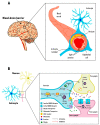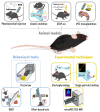Not Just a Bystander: The Emerging Role of Astrocytes and Research Tools in Studying Cognitive Dysfunctions in Schizophrenia
- PMID: 34069523
- PMCID: PMC8160762
- DOI: 10.3390/ijms22105343
Not Just a Bystander: The Emerging Role of Astrocytes and Research Tools in Studying Cognitive Dysfunctions in Schizophrenia
Abstract
Cognitive dysfunction is one of the core symptoms in schizophrenia, and it is predictive of functional outcomes and therefore useful for treatment targets. Rather than improving cognitive deficits, currently available antipsychotics mainly focus on positive symptoms, targeting dopaminergic/serotoninergic neurons and receptors in the brain. Apart from investigating the neural mechanisms underlying schizophrenia, emerging evidence indicates the importance of glial cells in brain structure development and their involvement in cognitive functions. Although the etiopathology of astrocytes in schizophrenia remains unclear, accumulated evidence reveals that alterations in gene expression and astrocyte products have been reported in schizophrenic patients. To further investigate the role of astrocytes in schizophrenia, we highlighted recent progress in the investigation of the effect of astrocytes on abnormalities in glutamate transmission and impairments in the blood-brain barrier. Recent advances in animal models and behavioral methods were introduced to examine schizophrenia-related cognitive deficits and negative symptoms. We also highlighted several experimental tools that further elucidate the role of astrocytes. Instead of focusing on schizophrenia as a neuron-specific disorder, an additional astrocytic perspective provides novel and promising insight into its causal mechanisms and treatment. The involvement of astrocytes in the pathogenesis of schizophrenia and other brain disorders is worth further investigation.
Keywords: animal models; astrocytes; behavioral tasks; blood–brain barrier; cognitive dysfunction; glutamate transmission; glutamate trisynapse; schizophrenia.
Conflict of interest statement
The author(s) declare no potential conflict of interest with respect to the research, authorship, and/or publication of this article.
Figures


References
-
- Lien Y.J., Tsuang H.C., Chiang A., Liu C.M., Hsieh M.H., Hwang T.J., Liu S.K., Hsiao P.C., Faraone S.V., Tsuang M.T., et al. The multidimensionality of schizotypy in nonpsychotic relatives of patients with schizophrenia and its applications in ordered subsets linkage analysis of schizophrenia. Am. J. Med. Genet. B Neuropsychiatr. Genet. 2010;153B:1–9. doi: 10.1002/ajmg.b.30948. - DOI - PubMed
Publication types
MeSH terms
Substances
Grants and funding
LinkOut - more resources
Full Text Sources
Medical

